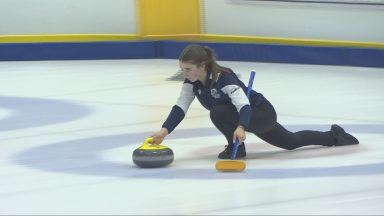A new loan system designed to help the development of young players has been launched by the Scottish FA, with top clubs now able to enter into agreed partnerships with other SPFL sides to move players easily.
Under the new “Cooperation System”, players aged between 16 and 21, who are eligible for Scotland national teams, can join a lower-league club on loan but move back and forth between their parent club and the cooperation club to increase their game time.
The new scheme, which clubs approved earlier this year, is designed to tackle a key area of concern over a vital stage of player development.
A report published last year showed that a lack of competitive game time was an issue for players in the transitional stage of their career who have moved from an academy environment to a professional contract.
The existing loan system, for all players and clubs, still exists but the cooperation system is now in place alongside it to offer clubs greater flexibility in how they develop players.
Previously, a young player who moved on loan could only be registered for his loan side and couldn’t return to his parent club outside of transfer windows. The system meant clubs could be reluctant to put a player out on loan for game time if they were worried an injury in their squad could leave them short of cover and unable to recall a promising young player from loan.
The new flexible system will only apply when clubs enter a formal Cooperation Agreement.
A club in the SPFL Premiership or Championship is permitted to operate as the parent club, and sign agreements with clubs further down the pyramid (League One, League Two, Highland League and Lowland League).
Championship clubs can also be both a parent club, to a team in a lower division, and a recipient club to a Premiership club. A club cannot sign a Cooperation Agreement with a club in the same league as their first team or B team.
Clubs in the top two divisions aren’t limited to just one partnership. The parent club may sign an agreement with a different club at each level of the pyramid, but a parent club cannot have two Cooperation clubs within the same division.
Similar programmes have been implemented in a number of countries, including Austria, Belgium, Croatia, Hungary and Serbia.
Alongside the new loan system, the governing body has also announced a change to the Reserve League.
The Under-18 level within Club Academy Scotland (CAS) and the SPFL Reserve League will also be replaced with a hybrid Under-19 category in CAS from the 2025/2026 season, with several overage players also allowed to participate.
Matches will take place on Monday instead of the current Friday, so clubs can expose the young players to the senior environment at the weekend and still include those who have had limited minutes on the Monday.
The Scottish FA’s chief football officer Andy Gould believes the plan addresses concerns and can deliver a “significant” increase in playing time at a crucial stage of development.
“The overriding message from the Transition Report was that we haven’t been producing enough opportunities for young players to play with and against senior players during that golden age of opportunity between 16 and 21 years of age,” he said. “We felt that the Cooperation System would be complimentary to the existing framework, with more freedom of movement for players who are on the cusp of the first team with their parent club.
“It’s rare in Scotland that we can get everyone united and on the same page and we are grateful to all the stakeholders who have worked together to make this happen. We are confident that we can see a significant increase in playing minutes for young players across the pyramid.”
SFA head of of men’s elite strategy Chris Docherty, who co-authored the report with Gould, said: “Throughout our research during the creation of the Transition Report, it was also clear from speaking to clubs that the gap between both the current Under-18 system and the SPFL Reserve League and the first team was far too big.
“This change to a new Under-19 level will benefit late maturing players, while the move to Monday matches should stop players missing minutes to sit on a bench at first team level.
“Also from consultations with coaches and ex-players, it was clear that the previous reserve system was a key part of their development and, by allowing a small number of overage players to play in this league, we hope we can create a hybrid model that benefits these young players by giving them chances to play against more experienced older pros as well as their peers.
“These changes – as well as the introduction of the revamped KDM Evolution Trophy – won’t fix all the problems instantly, but we believe they mark a significant moment as the game comes together to get behind the development of young Scottish players.”
The Cooperation System in detail
The Scottish FA has published full details of the new rules, with Gould and Docherty answering key questions about how it works and how it can help player development.
Why has this Cooperation System been introduced?
Based on the research we have carried out into similar systems in other countries, the Cooperation System affords more opportunities for the best young talent to get playing time. It offers an alternative to clubs and players, who may otherwise be denied a loan opportunity, whilst also having limited playing opportunities at their parent club. For example, clubs competing in Europe may not able to send young players on loan due to Homegrown Matchday Quotas and clubs without a large budget may carry smaller squads and not send best young talents on loan in case of an injury crisis. The Cooperation System gives young players the option to receive critical playing experiences at an appropriate level within the pyramid.
How does this system work?
A club can place a maximum of three players on a ‘Cooperation List’ and these players can move freely between the parent club and the club who they are in a Cooperation Agreement with. So, for example, if the parent club has injuries in the player’s position, they can recall the player, provided they give the minimum prescribed amount of notice to the Cooperation club. The parent club pays the salary for the player and – unlike with loan deals – they maintain the player’s registration.
What other countries use a version of this system?
Club Cooperation systems already operate in a number of countries, such as Austria, Belgium, Croatia, Hungary and Serbia.
Which clubs can enter into these Cooperation Agreements?
A club in the SPFL Premiership or Championship is permitted to operate as the parent club, and sign Cooperation Agreements with clubs further down the pyramid (League One, League Two, Highland League and Lowland League). Championship clubs are also able to be both a parent club, to a club in a lower division, and a recipient club to a Premiership club. A club cannot sign a Cooperation Agreement with a club in the same league as their first team or B team.
Can a club enter more than one Cooperation Agreement?
The parent club may sign a Cooperation Agreement with a different club at each level of the pyramid, but a parent club cannot have two Cooperation clubs within the same division.
Which players are eligible to move under the Cooperation System?
Only players who are eligible to play for the Scotland National Team and who are under the age of 21 would be able to participate on a ‘Cooperation List’. For the upcoming 2025/2026 Season, a player designated as Under-21 would refer to a player born in the calendar year 2005 or younger. This is in line with the definition used by other nations around Europe.
How many players can move to one club at a certain time?
The parent club, which pays the full salary for players under this system, is able to list a maximum of three players who would appear on a ‘Cooperation List’ between the two clubs.
Does the Cooperation System replace the previous Loans System?
The Cooperation System does not replace the Loans system, meaning clubs can use either of, or a combination of, both systems. A maximum of five players can be shared between two clubs (including loans and ‘Cooperation List’ players). Clubs can have a maximum of three loan players from club to club – therefore the maximum split would be 2/3 or 3/2 in terms of loan / cooperation. Clubs are under no obligation to use all three slots if they sign a Cooperation Agreement.
When can players move between clubs under the Cooperation System?
Clubs are entitled to change the players on the Cooperation List – to remove a player who has been recalled or not participating and replace him with another young player who may benefit from the experience – but only during the summer and winter transfer windows, as well as the extended loan windows that follows the transfer windows. Players who are on the Cooperation List are able to move freely between both clubs throughout the season, although there is a minimum playing time for a player to remain on a cooperation list beyond the cut-off date of March 31. As a minimum, a player on a Cooperation List must have played at least 15 minutes in at least five matches for the Cooperation club before March 31 to be eligible to feature for the Cooperation club after that date. This would ensure that a club cannot receive extra assistance for key games late in the season with a player being made available just for those games.
Follow STV News on WhatsApp
Scan the QR code on your mobile device for all the latest news from around the country


 SNS Group
SNS Group
























